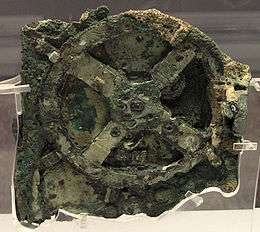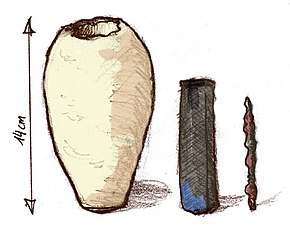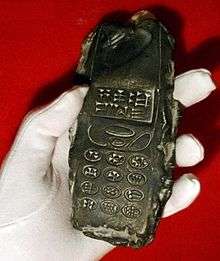Out-of-place artifact
An out-of-place artifact (OOPArt) is an artifact of historical, archaeological, or paleontological interest found in an unusual context, which challenges conventional historical chronology by its presence in that context. Such artifacts may appear "too advanced" for the technology known to have existed at the time, or may suggest human presence at a time before humans are known to have existed. Other examples may suggest contact between different cultures that is hard to account for with conventional historical understanding.

The term is used in fringe science such as cryptozoology, as well as by proponents of ancient astronaut theories, young Earth creationists, and paranormal enthusiasts.[1][2] It can describe a wide variety of objects, from anomalies studied by mainstream science to pseudoarchaeology far outside the mainstream to objects that have been shown to be hoaxes or to have mundane explanations.
Critics argue that most purported OOPArts which are not hoaxes are the result of mistaken interpretation and wishful thinking, such as a mistaken belief that a particular culture could not have created an artifact or technology due to a lack of knowledge or materials. In some cases, the uncertainty results from inaccurate descriptions. For example, the Wolfsegg Iron was said to be a perfect cube, but in fact it is not; the Klerksdorp spheres were said to be perfect spheres, but they are not. The Iron pillar of Delhi was said to be "rust proof", but it has some rust near its base; its relative resistance to corrosion is due to slag inclusions left over from the manufacturing conditions and environmental factors.[3]
Supporters regard OOPArts as evidence that mainstream science is overlooking huge areas of knowledge, either willfully or through ignorance.[2] Many writers or researchers who question conventional views of human history have used purported OOPArts in attempts to bolster their arguments.[2] Creation science often relies on allegedly anomalous finds in the archaeological record to challenge scientific chronologies and models of human evolution.[4] Claimed OOPArts have been used to support religious descriptions of prehistory, ancient astronaut theories, and the notion of vanished civilizations that possessed knowledge or technology more advanced than that known in modern times.[2]
Examples
The following are examples of objects that have been argued by various fringe authors (see list) to be out-of-place artifacts.
Unusual artifacts
- Antikythera mechanism: A form of mechanical computer created between 150 and 100 BCE based on theories of astronomy and mathematics developed by the ancient Greeks. Its design and workmanship reflect a previously unknown, but not implausible, degree of sophistication.[5][6]
- Maine penny: Some authors argue that the 11th-century Norwegian coin found in a Native American shell midden at the Goddard Site in Brooklin, Maine, United States is evidence of direct contact between Vikings and Native Americans in Maine. The coin need not imply actual exploration of Maine by the Vikings, however; mainstream belief is that it was brought to Maine from Labrador or Newfoundland (where Vikings are known to have established colonies as early as the late 10th century) via an extensive northern trade network operated by indigenous peoples.[7] If Vikings did indeed visit Maine, a much greater number and variety of Viking artifacts might be expected in the archaeological record there. Of the nearly 20,000 objects found over a 15-year period at the Goddard Site, the sole non-native artifact was the coin.[8]
- The Shroud of Turin contains an image that resembles a sepia photographic negative and is much clearer when it is converted to a positive image. The actual method that resulted in this image has not yet been conclusively identified. Mention of the shroud first appeared in historical records in 1357 and radiocarbon dating tests indicate it was probably made between 1260 and 1390.[9]
Questionable interpretations

- Baghdad Battery: A ceramic vase, a copper tube, and an iron rod made in Parthian or Sassanid Persia. Fringe theorists have hypothesized that it may have been used as a galvanic cell for electroplating, though no electroplated artifacts from this era have been found.[10][11] The "battery" strongly resembles another type of object with a known purpose – storage vessels for sacred scrolls from nearby Seleucia on the Tigris.[12]
- Dorchester Pot: A metal pot claimed to have been blasted out of solid rock in 1852. Mainstream commentators identify it as a Victorian era candlestick or pipe holder.[13][14]
- Kensington Runestone: A rune stone unearthed in 1898 in Kensington, Minnesota, entangled in the roots of a tree. Runeologists have dismissed the inscription's authenticity while geologists disagree as to whether the stone shows weathering that would indicate a medieval date.[15]
- Kingoodie artifact: An object resembling a corroded nail, said to have been encased in solid rock. It was handled a number of times before being reported and there are no photographs of it.[16][17]
- Lake Winnipesaukee mystery stone: Originally thought to be a record of a treaty between tribes, subsequent analysis has called its authenticity into question.[18][19]
- Sivatherium of Kish: An ornamental war chariot piece discovered in the Sumerian ruins of Kish, which is now in central Iraq, in 1928. The figurine, dated to the Early Dynastic I period (2800–2750 BCE), depicts a quadrupedal mammal with branched horns, a nose ring, and a rope tied to the ring. Because of the shape of the horns, Edwin Colbert identified it as a depiction of a late-surviving, possibly domesticated Sivatherium, a vaguely moose-like relative of the giraffe that lived in North Africa and India during the Pleistocene but was believed to have become extinct early in the Holocene extinction event. Henry Field and Berthold Laufer instead argued that it represented a captive Persian fallow deer and that the antlers had broken over the years. The missing antlers were found in the Field Museum's storeroom in 1977.[20]
- Tecaxic-Calixtlahuaca head: A terracotta offering head seemingly of Roman appearance found beneath three intact floors of a burial site in Mexico and dated between 1476 and 1510. There are disputed claims that its dating is older. Ancient Roman or Norse provenance has not been excluded.[21][22]
Alternative interpretations
- Abydos helicopter: A pareidolia based on palimpsest carving in an ancient Egyptian temple.
- Baalbek megaliths: Almost impossible to move with Bronze Age technology.
- Dendera Lamps: Supposed to depict light bulbs, but made in Ptolemaic Egypt.
- Hidden character stone: A Chinese petroglyph.
- Iron Man (Eiserner Mann): An old iron pillar, said to be a unique oddity in Central Europe.
- Iron pillar of Delhi: A "rust-proof" iron pillar which supposedly demonstrates more advanced metallurgy than was available in India before 1000 CE.
- Various igneous rock statues and buildings demonstrate an ability to accurately carve basalt, granite, diorite, etc., in the Bronze Age.
- London Hammer: Also known as the "London Artifact", a hammer made of iron and wood that was found in London, Texas in 1936. Part of the hammer is embedded in a limy rock concretion.
- Meister Print: A supposed human footprint in the Cambrian that was debunked as the result of a natural geologic process known as spall formation.
- Nazca Lines: Supposedly impossible to design without the aid of an aerial view.
- Newark Holy Stones: Used as extremely unlikely evidence that Hebrews lived in the Americas, but more probably a hoax.
- Pacal's sarcophagus lid: Described by Erich von Däniken as a depiction of a spaceship.
- Piri Reis map: Several ancient astronauts authors, and others such as Gavin Menzies and Charles Hapgood, suggested that this map, compiled by the Turkish admiral Piri Reis, shows Antarctica long before it was discovered (cf. Terra Australis).
- Quimbaya airplanes: Golden objects found in Colombia and made by the Quimbaya civilization, they allegedly represent modern airplanes. In the Gold Museum, Bogotá, they are described as figures of birds and insects.
- Saqqara Bird: Supposedly depicts a glider, but made in Ancient Egypt.
- Shakōkidogū: Small humanoid and animal figurines made during the late Jōmon period (14,000–400 BCE) of prehistoric Japan, said to resemble extraterrestrial astronauts.
- Stone spheres of Costa Rica: Inaccurately described as being perfectly spherical, and therefore demonstrating greater stone-working skill than was present in pre-Columbian times.
Natural objects mistaken for artifacts
- Aix-en-Provence petrified tools: Likely petrified tree remains.[23][24]
- Baigong Pipes: Their natural origins are challenged.[25][26][27]
- Eltanin Antenna: Actually a sponge.[28][29]
- Face on Mars: A pareidolia of a rock formation on Mars caused by the poor resolution of early orbital photography of the planet.
- Klerksdorp spheres: Actually pre-Cambrian concretions.[30][31]
- Paluxy River tracks: Identified by Biblical literalists as giant humanoid footprints found alongside dinosaur tracks. Actually tracks of theropod dinosaurs, and 1930s forgeries.
Erroneously dated objects
- Aiud object: An aluminum wedge found in 1974 in the Mureș River in central Romania, near the town of Aiud, is claimed by Romanian UFOlogists to be of ancient and/or extraterrestrial origin,[32] yet it is more likely a fragment of modern machinery lost during excavation work.[33]
- Coso artifact: Thought to be prehistoric; actually a 1920s spark plug.[4]
- Malachite Man: Thought to be from the early Cretaceous; actually a post-Columbian burial.[34][35]
- Wolfsegg Iron: Thought to be from the Tertiary epoch; actually from an early mining operation. Inaccurately described as a perfect cube.
Modern-day creations, forgeries and hoaxes
- Babylonokia: A clay tablet made in 2012 and shaped like a mobile phone. Fringe scientists and alternative archaeology proponents subsequently misrepresented a photograph of the artwork as showing an 800-year-old archaeological find. The story was popularised in a video on the YouTube channel Paranormal Crucible and led to the object being reported by some press sources as a mystery.
- Acámbaro figures: Mid-20th century figurines of dinosaurs, attributed by Waldemar Julsrud to an ancient society.
- Calaveras Skull: A human skull found by miners in Calaveras County, California, which was purported to prove that humans, mastodons, and elephants had coexisted in California. It was later revealed to be a hoax.
- Crystal skulls: Supposedly demonstrate more advanced stone-cutting skill than was present in pre-Columbian Mesoamerica. Appear to have been made in the 19th century.
- Ica stones: Depict Inca dinosaur-hunters, surgery, and other modern or fanciful topics. Collected by Javier Cabrera Darquea, who claimed them to be prehistoric.
- Japanese Paleolithic hoax: Perpetrated by discredited amateur archaeologist Shinichi Fujimura.
- Los Lunas Decalogue Stone: Supposedly made by Pre-Columbian Israelite visitors to the Americas. Generally believed to be a modern-day hoax.
- Michigan relics: Supposedly ancient artifacts which proved that people of an ancient Near Eastern culture had lived in Michigan, United States; they are archaeological forgeries.
- Tucson artifacts: Thirty-one lead objects that Charles E. Manier and his family found in 1924 near Picture Rocks, Arizona, which were initially thought by some to be created by early Mediterranean civilizations that had crossed the Atlantic in the first century, but were later determined to be a hoax.
Entirely fictional
- Dropa stones: Popularized by David Gamon (as David Agamon) as part of his false document Sungods in Exile.
See also
- Ancient technology
- Lost inventions
- Anachronism
- Lazarus taxon – when a biological lineage is discovered to have been alive long after it was assumed extinct.
- Geofact – Geological artifacts that look like man-made ones.
Authors and works
- Charles Fort, researcher of anomalous phenomena
- Fortean Times
- Peter Kolosimo
- Fingerprints of the Gods, book by Graham Hancock
- Vadim Chernobrov, researcher of anomalous phenomena, writer
- Michael Cremo, author of several books including Forbidden Archeology
- Charles Berlitz, linguist and writer of anomalous phenomena
- The Mysterious Origins of Man, originally aired on NBC in 1996
References
- Benjamin B. Olshin (2019). Lost Knowledge: The Concept of Vanished Technologies and Other Human Histories. Brill. pp. 353–. ISBN 978-90-04-35272-8.
- O'Hehir, Andrew (August 31, 2005). "Archaeology from the dark side". Salon.com. Retrieved 19 April 2010.
- R. Balasubramaniam (2001). "New Insights on the Corrosion Resistant Delhi Iron Pillar". In Rao, Ramachandra Patcha; Goswami, Nani Gopal (eds.). Metallurgy in India: a retrospective (PDF). India International Publisher. pp. 104–133.
- Stromberg, P, and PV Heinrich (2004) The Coso Artifact Mystery from the Depths of Time? Archived 2007-12-14 at the Wayback Machine, Reports of the National Center for Science Education. 24(2):26–30 (March/April 2004) Retrieved March 8, 2014.
- "The Antikythera Mechanism Research Project Archived 2008-04-28 at the Wayback Machine", The Antikythera Mechanism Research Project. Retrieved 2007-07-01 Quote: "The Antikythera Mechanism is now understood to be dedicated to astronomical phenomena and operates as a complex mechanical "computer" which tracks the cycles of the Solar System."
- Paphitis, Nicholas (December 1, 2006). "Experts: Fragments an Ancient Computer". The Washington Post. Athens, Greece.
Imagine tossing a top-notch laptop into the sea, leaving scientists from a foreign culture to scratch their heads over its corroded remains centuries later. A Roman shipmaster inadvertently did something just like it 2,000 years ago off southern Greece, experts said late Thursday.
- "Vinland Archeology". Smithsonian Institution National Museum of Natural History. Retrieved 2011-08-24.
- "Bye, Columbus". Time. December 11, 1978.
- Allen, Nicholas P. L. (11 November 1993). "Is the Shroud of Turin the first recorded photograph?" (PDF). The South African Journal of Art History: 23–32.
- Von Handorf, DE, and DE Crotty (2002) The Baghdad battery – myth or reality? Plating and Surface Finishing. vol. 89, no. 5, pp. 84–87.
- Flatow, I (2012) Archaeologists Revisit Iraq. interview with Elizabeth Stone, Talk of the Nation, National Public Radio. Washington, DC.
- Keith Fitzpatrick-Matthews (26 December 2009). "The batteries of Babylon: evidence for ancient electricity?". Bad Archaeology. Retrieved 17 December 2016.
- Steiger, B. (1979) Worlds Before Our Own. New York, New York, Berkley Publishing Group. 236 pp. ISBN 978-1-933665-19-1
- Fitzpatrick-Matthews, K, and J Doeser (2007) Metallic vase from Dorchester, Massachusetts. Bad Archaeology.
- "Calcite Weathering and the Age of the Kensington Rune Stone Inscription (Lightning Post)". Andy White Anthropology. Retrieved 24 May 2019.
- Sir David, B (1854) Queries and Statements concerning a Nail found imbedded in a Block of Sandstone obtained from Kingoodie (Mylnfield) Quarry, North Britain. Report of the Fourteenth Meeting of the British Association for the Advancement of Science vol. 51, John Murray London.
- Fitzpatrick-Matthews, K, and J Doeser (2007) A nail in Devonian sandstone from Kingoodie, Scotland. Bad Archaeology.
- anonymous (nd) The Mystery Stone. Archived 2010-09-14 at the Wayback Machine Museum Exhibits, New Hampshire Historical Society, Concord, New Hampshire.
- Klatell, JM (July 23, 2006). New England's 'Mystery Stone': New Hampshire Displays Unexplained Artifact 134 Years Later. Associated Press. Retrieved March 8, 2014.
- Naish, D. (2007) What happened with that Sumerian 'sivathere' figurine after Colbert's paper of 1936? Well, a lot. Tetrapod Zoology.
- Hristov, RH, and S. Genoves (2001) Tecaxic-Calixtlahuaca. Dept. of Anthropology at the University of New Mexico, Albuquerque, New Mexico.
- Schaaf, P and GA Wagner (1991) Comments on 'Mesoamerican Evidence of Pre-Columbian Transoceanic Contacts,' by Hristov and Genovés. Ancient Mesoamerica. 10:207–213.
- Stillman, B (1820) Curious Geological Facts: The American Journal of Science. v. 2, no. 2, pp. 144–146. (November 1820). Internet Archive copy archived on May 27, 2011.
- Fitzpatrick-Matthews, K (2007) Tools in rock at Aix-en-Provence. Archived from the original on November 16, 2016.
- Anonymous (2002) Mysterious Pipes Left by 'ET' Reported from Qinghai. People's Daily Online, Beijing, China. Retrieved March 8, 2014.
- Anonymous (2002) Chinese Scientists to Head for Suspected ET Relics. People's Daily Online, Beijing, China. Retrieved March 8, 2014.
- Dunning, Brian. "Skeptoid #181: The Baigong Pipes". Skeptoid. Retrieved March 8, 2014.
- Brookesmith, P (2004) The Eltanin Enigma. Archived 2013-04-03 at the Wayback Machine Fortean Times. (May 2004). Retrieved March 8, 2014.
- Heezen, BC, and CD Hollister (1971) The Face of the Deep. Oxford University Press, New York. 659 pp. ISBN 0-19-501277-1
- Cairncross, B (1988) "Cosmic cannonballs" a rational explanation: The South African Lapidary Magazine. v. 30, no. 1, pp. 4–6.
- Heinrich, PV (1997) Mystery spheres: National Center for Science Education Reports. v. 17, no. 1, p. 34. (January/February 1997)
- RealitateaTV (2014) "Specialist despre obiectul preistoric neidentificat din depozitele muzeului de istorie: 'aparţine unui robot primitiv'", RealitateaTV.net.
- Hilblairious (2014) "Aluminum, Aliens (1): What "THEY" left Behind in Aiud", Hilblairious.blogspot.ca.
- Coulam, NJ, and AR Schroedl (1995) The Keystone azurite mine in southeastern Utah. Utah Archaeology. 8(1): 1–12.
- Kuban, GJ, (2005) "Moab Man" – "Malachite Man". The Paluxy Dinosaur/"Man Track" Controversy. Retrieved March 8, 2014.
External links
| Wikimedia Commons has media related to OOParts. |
- Critical perspective on Creationist and New Age claims related to out-of-place artifacts at Bad Archaeology
- Archaeology from the dark side at Salon.com
- Out-of-place artifacts article at Cult and Fringe Archaeology

